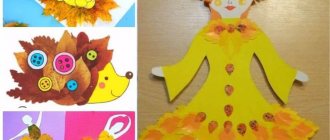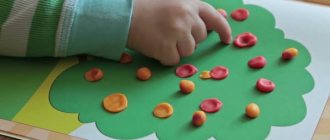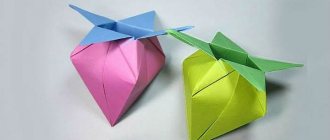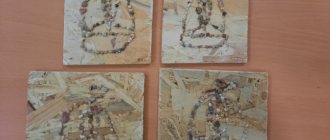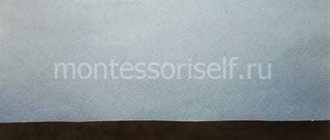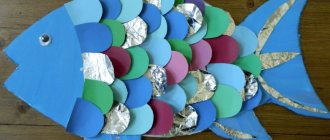For the successful all-round development of a child, activities to develop fine motor skills are of great importance. One of the types of such activities is applications made from colored paper, templates for which were developed by methodologists taking into account the characteristics of the age groups of preschoolers.
It is important that the complexity of the task corresponds to the age of the child, that classes are carried out systematically, gradually becoming more difficult, and are carried out under the supervision and assistance of adults.
What are the benefits of template applications for development?
Paper applications are a creative process through which children learn about the world around them and acquire many skills. In addition to the development of fine motor skills of the hands, this includes coordination of movements, the study of colors and their combinations, the concept of composition, familiarity with various materials and textures, the development of observation, imagination and fantasy.
Working on an application in a team promotes organization, restraint, and accuracy. It is also necessary to note the development of spatial imagination: when doing appliqué, children create a whole from several components and, conversely, learn to divide the whole into parts.
Scientists have proven that in the cerebral cortex, the center responsible for fine motor skills is located next to the speech center and contributes to the development of speech skills.
Simple applications for children 2-3 years old
Simple applications made from colored paper using templates can be practiced from the age of 2. However, some experts believe that children as young as 1 year can perform feasible tasks.
Initial lessons involve gluing pieces of paper onto a sheet in any form. At this stage, the child must understand and remember the basic actions: spread, turn over, apply, smooth. Kids are still attracted to the process itself; they will strive for the result later.
At the second level of complexity, templates are used. The child must place the elements also chaotically, but within the contour, and a certain image appears.
Application template from colored paper “Hedgehog”
A template is a schematic image of a future picture, drawn or printed on a printer. Simple templates for applications made from colored paper can include, for example, a Christmas tree with balls, a tree with apples, and others.
For such work, you need to prepare elements: balls, apples, etc. The child must determine for himself how to arrange them on the templates.
Palm tree applique template
Flower applique template
For small children, it will be interesting to perform a simple cut-out appliqué. The child watches the adult tear the paper into long strips, then tears them into shreds himself. These pieces need to fill the outline.
If the child wants to tear the paper himself, then these uneven, awkward strips can also be used to create an applique, for example, grass. Ants are drawn using finger paints.
Further, the task becomes more complicated: you need to hit the element on a specific place in the template or drawn outline. So, using cut out circles, an image of a caterpillar is created. At this stage, children are no longer interested only in the process, but also in the result.
When making appliqués from colored paper using templates and contours with children under 3 years of age, prepared cut out elements are used.
A three-year-old child can already be taught the skills of working with scissors with rounded ends.
At the same time, it is necessary to explain how to properly hold scissors and paper so as not to get hurt. You need to start with straight cuts, then work on bends and roundings.
At this age, children are already able to create simple plot pictures. Elements pasted onto the template allow you to create a specific image.
The background for the application can be a drawn outline with partially drawn elements. For example, children can populate a template aquarium with algae and stones at the bottom with inhabitants: fish, jellyfish, etc.
An interesting activity can be connecting and gluing a cut picture. If a child copes with such a task easily, it is recommended to complicate it: add raindrops to the umbrella, glue windows to the house with an attached roof. Such activities develop imagination, observation, and a sense of proportion.
Complex techniques for paper art
Moving from flat applique to more complex types of paper crafts, it is worth recalling other varieties:
- Volume applique. Combines several other subtypes of working with colored paper. It is intended to use flat, three-dimensional, convex and curled paper fragments in one image.
- Application made of thin tubes. Old rolled up newspapers are a great material for crafts. These are “twigs” for a nest for Easter eggs. You can weave a bread box or basket out of them, painting them like wood. Imitation of metal elements will help to decorate an old sugar bowl, samovar and teapot for a cottage in a “vintage” style.
- Decoupage. A popular technique for which you will have to purchase special napkins with a suitable image in order to update kitchen utensils and interior items.
As you can see, applique, planar and volumetric, has great potential for those who want to do some kind of creativity at home. It's much easier than painting pictures, crocheting blankets or weaving macrame.
You can choose just one or master several types of Japanese origami, which adults are often keen on.
Applications for children 4-5 years old
At this age, colored paper applications and templates for them become more complex. By preparing, together with an adult, elements for a future picture, the child shows more independence: cuts, selects colors and, thus, gains an understanding of composition.
This activity develops logical thinking and allows you to show creative inclinations.
For children 4-5 years old, a fun activity is making cards, which they then give to their parents and friends.
The base is folded in half and elements are glued inside the postcard to form a plot picture.
The templates developed by specialists are only examples indicating the direction of work.
Parents and educators can contribute their ideas. For example, using a cut out outline of a baby’s palm in an applique – such pictures evoke amazement and delight in children.
Applications with palm
The technique of appliqué using only circles reveals for the child the relationship between the parts and the whole.
When developing a child’s creative imagination, you should show him various techniques for working with paper: for example, folding it in the shape of an accordion. For such a picture you need to prepare a base and draw contours. The gluing process also becomes more complicated.
Complex applications for children 6-7 years old
Children of senior preschool and primary school age already have certain skills.
Practicing appliqué work from colored paper using templates during this period helps further develop fine motor skills, thinking, memory and concentration, and develops the ability to plan one’s activities.
An important circumstance is that the child foresees the final result of his work.
At this age, children develop the skill of cutting out individual parts and solid silhouettes, symmetrical elements from paper folded in half, as well as the ability to create compositions and correctly arrange their individual parts on a base.
At this stage, children study color combinations, analyze and compare details. The texture of the material also becomes varied: in addition to ordinary colored paper, creped (“crumpled”), streaked (glossy), textured (embossed or imitating velvet), and foil are used.
During this period, you can move on to volumetric symmetrical compositions.
To complete this task, templates (clouds, balloons) are cut out in the usual way. Next, two identical templates are folded in the center and fastened together (can be sewn). The prepared elements are glued to the base.
To make a three-dimensional bird, the template is folded in half and glued together, except for the wings, which are folded along the dotted line.
The resulting result can be pasted with one side and a wing onto the base (in the form of an applique) or turned into a craft by tying it to a thread and hanging it on a branch.
Having mastered the basics of composition at the previous stages, children aged 6-7 years are able to create entire paintings - landscapes, still lifes, using ready-made templates for appliqués from colored paper or making them with the help of a teacher or parents.
Applications using a disposable plate
Disposable plates are a convenient material with which you can create original and beautiful compositions. Made of polystyrene or cardboard, of different colors, with different embossed patterns, they can be both the basis for an applique and elements for it.
You can involve children from a young age in making applications from colored paper on a disposable plate using templates. On a prepared colored background, children arrange simple elements in the form of a pattern.
A more complicated option is to use two or more colors for the background and more complex elements. Children 6-7 years old create thematic compositions on plates or use them as material for individual elements.
Examples of gradually more complex appliqués on plates:
Volume of applique crafts
Creating a pattern by gluing multi-colored pieces of fabric or paper - applique. Making a three-dimensional applique craft is not an easy task. However, having the initial simple skills to create such images, you can engage in such creativity.
If you devote a little time to activities with your baby every day, then little by little, without much difficulty, he will master this technique and independently “create” to the delight of himself and those around him. For such crafts, you need to stock up on colorful paper, glue, scissors, cardboard and a stencil. Good luck.
Combined applications
When making appliqués from colored paper, the patterns can be diversified by combining different materials.
Cereal applications
This type of application can be done even with small children. The algorithm of work is as follows: an adult applies glue to the prepared drawing, the child sprinkles cereal on it and lightly presses it with his finger.
The remaining grains that are not glued need to be shaken off. This activity instills attentiveness and accuracy in the child.
Older children can use different types of cereals. In this case, the glue is applied one by one to individual areas. To make the picture more colorful, it is recommended to first tint the cereal with gouache in different colors. You can use your child’s own drawing as a template; this will stimulate him and inspire him.
Button applications
To perform such an application, preliminary preparation is necessary. After studying the drawing and choosing colors, the child, with the help of adults, selects buttons that match the color and size. Then you should lay them out in a picture to visualize the desired result, and begin gluing.
For younger children who do not yet have the necessary skills, you can apply a drawing according to a template on a layer of plasticine - the child will attach the buttons by pressing. This technique is also applicable when working with cereals.
For combined applications, cotton wool, napkins, eggshells, natural materials - leaves, petals, seeds and much more are also used.
Tips for parents
- For paper and fabric appliqué, choose material in bright colors - the more colors, the more attractive the work is for the baby.
- In your work you may need different types of glue. The paper “lays” better on paste or PVA glue, and for gluing seeds or beads you can use stronger “Moment” glue. In this case, you will need your mother's help.
Creative activities help to establish close contact between parents and children. After all, in the process you will have to communicate a lot, discuss, explain, analyze. This teaches children to engage in dialogue, helps to establish and strengthen emotional contact. And of course, when the work is finished, do not forget to praise your child, because he tried very hard!
Multilayer applications
Multilayer (overlay) applications made of colored paper or other materials are made using templates designed or made independently.
This kind of work develops spatial imagination and cultivates aesthetic taste. They are made from paper, fabric, leather, felt - the main thing is that the edges of the material do not fray.
Multilayer applications, like other varieties, come in varying degrees of complexity. For little ones, this is a simple matter of gluing parts on top of each other. By fastening elements only on one edge, you can create a three-dimensional effect.
More complex appliqués have more details and require good scissor skills and a sense of proportion and color.
Older children, with developed fine motor skills and the skills to make complex parts, create real works of art - unusual compositions and even portraits. Light and shadow effects give them special color.
Multilayer appliqué is a truly creative process in which the child’s imagination and artistic abilities are revealed. It is necessary to think through the image, color scheme, and sequence of action, so this type of work requires a certain level of intelligence.
A little about the types of applications
By topic, the following types of applications can be distinguished:
- Subject - a simple type of application for children. An element is cut out of the material and glued to the base.
- Subject - the image no longer consists of one, but several links that make up an event or action in the background.
- Decorative - forms a repeating pattern that is used to decorate albums, frames and household items.
Paper is the main material for applique. However, in addition to it, you can use other materials, whatever your imagination allows: fabric, leather, multi-colored beads, seed beads, woolen threads, leaves, seeds, cereals and much more.
By color, the applique can be colored, black and white or single color.
Depending on the volume, flat and volumetric applications are distinguished.
Overhead, cut-off, silhouette, modular, ribbon... and this is not all types of applique!
And to understand how diverse this art technique is, it is enough to get acquainted with the most popular and interesting types of children's applications, examples of which are given below.
Piece applications
Appliqués made from cut or torn pieces of colored paper using templates are quite simple and can be done even by small children. You need to apply a drawing to the base sheet. In addition to ready-made templates, you can use children's coloring books or come up with a sketch yourself.
The production of appliqué elements is carried out together with the child - small children happily tear the paper into pieces. If you already have skills in working with scissors, you can allow these elements to be cut out.
An important detail: the younger the child, the larger the fragments should be.
Having selected the desired colors, you can begin gluing.
The glue is applied not to small parts, but to the template, in sections. When working with children, this process is carried out by an adult; older children themselves apply the glue with a brush. When gluing pieces of paper, the child must accurately fall into the outline.
A type of applique made from pieces is trimming. This technique is quite complex, but children 6-7 years old are quite capable of it, especially when working in a group.
To master the cutting technique, teachers and parents are offered master classes on this topic.
Newspaper simple applications
The fact is that in many sets there are no gray sheets. The reason is unknown, but many interesting crafts are deprived of due attention because of this.
Wonderful koala bear. The application itself is simple to do and is interesting for the child. Therefore, a simple newspaper without color pictures is used. But the kid always asks what is written on the image.
The darkened areas of the photographs will be useful for the nose and ears. And you can cut out the torso in such a way that you get a whole newspaper quote, proudly emblazoned on the chest of the silhouette.
Such crafts can become the basis for an entire album, which will be viewed with interest later by an adult son or daughter. A kind of historical “collection”.
Autumn themed applications
The bright colors of autumn make it possible to create colorful pictures of autumn nature. For applications on this theme, both colored paper and natural materials are used: multi-colored leaves, petals of late flowers, seeds, spikelets, twigs and other objects.
When making autumn-themed applications from colored paper using templates and in a free composition, the main attributes are preserved - flowers, mushrooms, fruits, acorns, and tree silhouettes are cut out and painted. An obligatory component is autumn leaves.
When working with natural material, you need to prepare it. The collected leaves must first be leveled and dried under pressure. If the leaf needs to be given any shape, then a fresh leaf is used for this, which is then dried.
For collages and mosaic paintings, you can prepare cardboard templates onto which the elements are glued.
Autumn nature is fertile ground for the flight of children's imagination. Leaf applications placed in a photo frame will decorate any interior.
Autumn lanterns will also be a spectacular decoration. To do this, the outside of the glass vessel is covered with multi-colored leaves (paper or natural), and a small candle is placed inside.
Horse sticker
Everyone really likes this idea. We prepared carrots for the horse. The teacher needs to prepare all the details, that is, cut them out. For striped harness, strips of multi-colored paper are glued alternately onto a white sheet, which is cut crosswise into pieces that are neither long nor wide.
The baby is required to concentrate so as not to confuse the sequence when sticking. Carrot then face. The harness and then the bangs. You can make the wrong option the other way around and laugh at such a mistake together.
Winter themed applications
To create winter and, in particular, New Year's applications, any of the described techniques is used, depending on the age of the children.
The most common type of winter applique is snowflakes - this is a subtype of silhouette type applique. It is recommended to fold the sheet correctly, trim the edge and sharp corner, and make cuts on plain paper first - this is how the skill is developed.
In addition, pendants made of such snowflakes decorate the room. Thin, airy snowflakes can be glued to windows and other surfaces.
For small children, it is better to prepare templates (circles with an outline) and make a broken snowflake from pieces. For flat, voluminous, multi-layer snowflakes, you need to prepare patterns for cutting.
To make a traditional Christmas tree, kids use triangles from green paper, a snowman is made from white circles, and a teacher or parent helps add details to the applique.
Older children can be asked to make a Christmas tree from strips of paper or create a picture of a winter forest using templates using small pieces of paper or cotton wool.
A Christmas tree made of paper balls looks bright and voluminous. For this purpose, a template and elements are made from crepe paper. The main color is dark green; multi-colored balls are made for the garland.
After applying glue to the template, it is recommended to first position the garland, then fill the outline with “needles” and complete the applique with a star and base.
An interesting applique depicting winter accessories allows children to show their creative imagination.
The hat and mittens can be decorated with any ornament, animal figures, winter pictures, beads or rhinestones.
Cotton wool is used to imitate fur.
Using a disposable plate, you can make a polar bear mask craft. Holes are cut out in the plate for eyes, the surface is covered with pieces of paper, and a disposable cup is used for the nose.
Senior preschoolers and elementary school students are able, under the guidance of adults, to create complex winter landscapes using mixed techniques.
Applique of cereals, seeds and shaped pasta
You will need:
- Thick cardboard
- Cereals – millet, buckwheat, melon, watermelon, sunflower seeds
- PVA glue
- Glue brush
- Gouache paints
- Brush
- Water jar
- Simple pencil
For the applique, choose a template picture with clear contours and a minimum of small details. This could be an image of your favorite fairy tale characters (for example, Kolobok), a schematic image of animals (an owl, a hedgehog) and the like.
Ask your child to tell you who is in the picture. Then start applique. Transfer the image onto cardboard - at this stage the baby may need your help. Complete the drawing with an image of a flower, tree, stump, or sun. Ask your child to color the picture, not with paints, but with grains. This is where imagination comes in handy! The bun can be “painted” with millet: apply a thick layer of glue to the image and sprinkle generously with millet. Wait until the glue dries, then carefully shake off the remaining cereal from the sheet. A tree trunk can be “painted” with buckwheat, owl feathers can be made from sunflower seeds, vermicelli can be used for animal fur, larger pasta can be used for sun rays, and bird wings can be sprinkled with semolina. Draw small details of the drawing - eyebrows, mustaches, eyes - with paints. Invite your child to experiment with cereals: for example, the character’s eyes can be made from buckwheat, dark watermelon seeds and even curly pasta.
Important: the seeds can be painted! For example, light pumpkin seeds or pasta can be given any color with gouache.
The more materials you use in your work, the more interesting it becomes. For example, to create roof tiles, you can use not only cereals, but also pencil shavings (they remain in the sharpener). You can and should come up with any compositions, experiment with unusual seeds and cereals!
Spring themed applications
Snowdrops and lilies of the valley, starlings and flowering trees - these signs of spring are traditionally used in children's applications made from colored paper using templates. The little ones perform simple tasks, placing prepared elements on the contours. These same images can be complicated by adding pictures of spring nature.
More complex compositions - voluminous, multi-layered, with a large number of elements - are created by children who have the skills to work with glue, scissors, a brush and use different techniques.
Lilacs in a vase made of cereals, a spring picture using drawing and appliqué techniques - these and many other ideas are offered by experts to parents and educators for educational activities with children.
Applique is a visual activity. Having achieved the desired result, the child experiences aesthetic pleasure, thereby joining the world of beauty, the world of art. A simple and accessible way for children to create artwork makes appliqué one of the favorite types of educational activities for children.
Volumetric origami applications
Paper is the simplest material that can be worked with using different techniques, using only scissors and glue. There is a special technique where you can do without glue at all - this is modular origami.
Three-dimensional figures using the origami technique are made from identical or similar fragments, assembling any objects from them:
- Peacock.
- Flamingo.
- Swan.
In most cases, when talking about appliqué, we mean flat images. But the volumetric variety remains the most impressive. Talented children make something unimaginable from the modules, including cakes and buildings of Orthodox churches.
Traditional Japanese applique
It was once invented to work with rice paper in Asia; the pliable material holds its shape well when curved. Traditional origami cranes have become “classics of the genre.” Having a scan diagram and a brief explanation of the stages of work, it is easy to repeat any sample:
- Origami "Cat".
- Jumping frog using origami technique.
- Origami fish.
Volumetric paper kusudama balls
Amazing crafts assembled from identical modules also came to Europe from Japan. These are kusudama balls, which were once made as amulets.
Today, this technique is taught in the school curriculum on labor and in handicraft clubs. They can be used as a gift filled with candy or to decorate a child's room.
The photo shows a voluminous do-it-yourself kusudama appliqué in the form of a wreath.
Origami unwrapping and “wet technique”
Amazing techniques for three-dimensional figures are within the reach of those who have well-developed spherical thinking. Masters transform solid pieces of whatman paper, obtaining something similar to a sculpture of strict geometric shapes:
- A whole museum of forest trophies made of paper. In Japan today it is not customary to boast about one’s hunting achievements, so a paper alternative has appeared.
- Parrots are one of the best examples of Japanese technology.
Working with wet paper purposefully gave rise to a new type of origami, where curves and smooth outlines are held in high esteem. Wet folding is more reminiscent of working with fabric or thin leather.
Here is an example - a Lion and a Fox with a Fox Cub.

